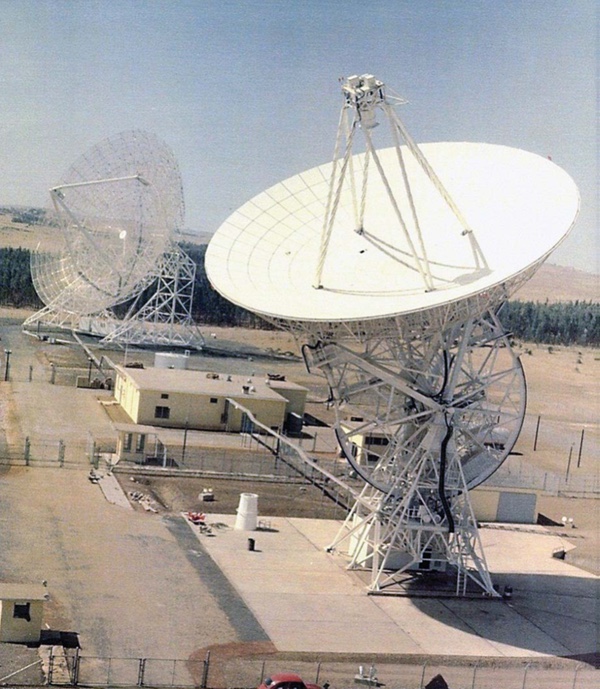Stealing secrets from the ether: missile and satellite telemetry interception during the Cold Warby Dwayne Day
|
| CIA officials sometimes had a knack for applying winking codenames to their projects, and this facility was a classic case, because “tacksman” is a Scottish term for somebody who paid rent to his landlord, usually a clan chief. |
Now information has come to light on the origin of the TACKSMAN facility as well as other Cold War era projects to gather the faint signals of Soviet missiles and spacecraft as they rose above distant horizons. Throughout the Cold War, the United States operated numerous ground stations around the world as well as aircraft and satellites for collecting these signals, then referred to as telemetry. New information was recently declassified in a two-part official history of American telemetry intelligence collection over 50 years. Combined with other declassified information on American collection systems, it is now possible to put more pieces of the puzzle together and understand this obscure aspect of Cold War intelligence gathering.
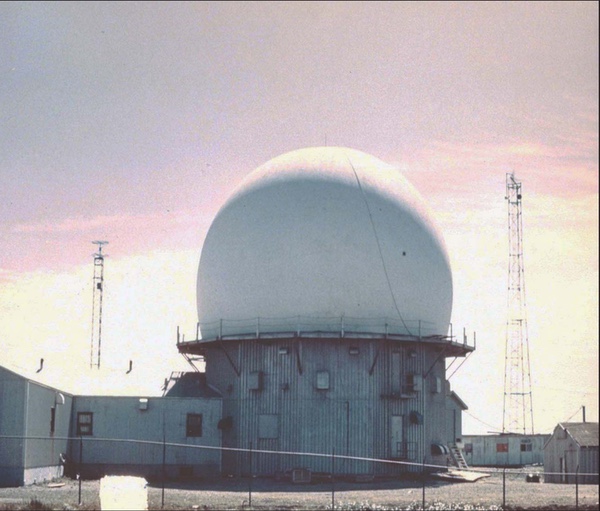 The ANDERS site on Shemya, a remote Alaskan island, was a major Cold War telemetry interception site. (credit: NSA) |
TELINT
The newly declassified history, The Foreign Missile and Space TELEMETRY Collection Story – The First 50 Years, was written by Richard L. Bernard in 2004. The released history on the National Archives website is in two parts. Part 1 covers the 1950s and 1960s, and Part 2 covers the 1970s, 1980s, and the 1990s. Substantial portions of both parts remain redacted in the released documents. Nevertheless, not much of this information was previously public, or was public but not officially confirmed, so this official history enables a better understanding of the outlines of telemetry intelligence (TELINT) collection during the second half of the last century.[2] A table of contents refers to land-based, sea-based, and airborne collection, and then “Very Special Efforts,” a euphemism that covers both satellites and other unique efforts at collecting signals.
Early in his history, Bernard refers to two “outstanding leaders” who significantly influenced early telemetry collection efforts: William J. “Bill” Perry and Charles C. Tevis. Perry played a major role in industry, developing various systems for intercepting Soviet signals. He eventually became Secretary of Defense in the 1990s. Tevis worked within the government and constantly pushed for new and better collection systems, and eventually had two satellite systems named in his honor.[3]
What Bernard’s history makes clear is that the United States intelligence community, led primarily by the National Security Agency (NSA), but also the CIA and the military services, created a vast and expensive global network of systems for gathering missile and satellite signals. But despite the expense, the intelligence collected by this system was incredibly valuable. As one NSA analyst in the research and development group in the 1950s stated, “one good intercept is worth five million dollars.”[4]
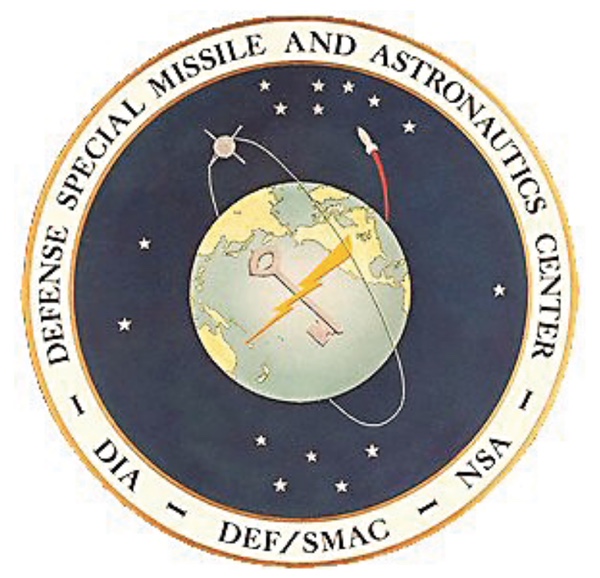 Early 1970s logo for the joint Defense Special Missile and Aerospace Center. Originally created by the NSA as SMAC, later it became DEF/SMAC, and finally DEFSMAC. It was the primary center for analyzing missile and space telemetry intercepted from Soviet and other nations’ vehicles during the Cold War. (credit: NSA) |
Grabbing the signals
The first Soviet missiles were captured V-2 rockets and they used the same telemetry systems developed by the Germans—systems that the United States also inherited with its captured V-2s. But Soviet missile designers soon expanded their systems, and the US intelligence community was in a constant state of catch up. This was not only a matter of dealing with new systems and technologies, but the very nature of the telemetry collection operation itself. As one NSA engineer explained: “The raw telemetry data is noisy, degraded, incomplete, and imperfectly instrumented, and from this uninviting material it is necessary to extract the particulars of the rocket flight, the characteristics and performance of the missile, and the implications of the missile operation.”[5] (See this brochure on Cold War TELINT operations also written by Bernard.)
| In 1964, DEFSMAC recorded 174 Soviet missile launches, including 48 ICBM and submarine-launched ballistic missile (SLBMs) launches. By 1978, the number of ICBM and SLBM launches had increased to 108, with a five-fold increase in total launches to 1,045. |
In addition, the telemetry analysts were not only going after signals being emitted by the missiles, rockets, and later spacecraft, but also signals being sent from the ground to them. For instance, one missile might have an inertial guidance system and send signals to the ground, but another might be radar guided from the ground and intelligence analysts wanted to gather those signals as well as the signals emitted by the rocket. In some cases, the Soviets sent signals to the missiles that were then returned to the ground, providing two data streams to be collected. The NSA not only gathered signals coming down from Soviet spacecraft, but also the commands that were sent to them in orbit, or even on their way to the Moon and planets. New techniques and systems were focused on those signals.
According to Bernard, the number of American organizations collecting telemetry intelligence in the latter 1950s increased rapidly. These organizations often had overlapping and competing collection capabilities, and did not always share their data. It took years for government officials to consolidate these efforts and make them more systematic. The Special Missile and Aerospace Center (SMAC) was formed by the NSA in 1964 to better coordinate collection and analysis efforts, and then in 1965 evolved into Defense SMAC, or DEF/SMAC—later simply DEFSMAC.[6] In 1963 the CIA established its Foreign Missile and Space Analysis Center (FMSAC).
The number of intercepts of various types increased rapidly. In 1956, US intelligence agencies made 18 intercepts of Soviet intermediate range ballistic missiles and “verticals” (most likely sounding rockets), which increased to 71 three years later. The first intercepts of Soviet ICBMs occurred in 1958—only four—increasing to 15 a year later. Intercepts of space vehicles also started in 1957 and began increasing as well.[7]
In 1964, DEFSMAC recorded 174 Soviet missile launches, including 48 ICBM and submarine-launched ballistic missile (SLBMs) launches. By 1978, the number of ICBM and SLBM launches had increased to 108, with a five-fold increase in total launches to 1,045. Soviet space launches had also increased, from 36 in 1964, to 92 by 1978, 44 of which were reconnaissance satellites.[8] (For an overview of DEFSMAC, see this brochure also written by Richard Bernard.)
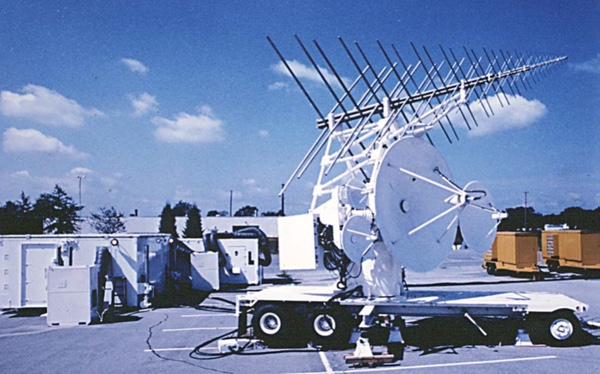 A LEFTOUT mobile ground station that was deployed during the Cold War to intercept satellite signals. (credit: NSA) |
Grabbing signals on the ground: EGGSHELL, TACKSMAN, BANKMAN, HIPPODROME
From 1956 to 1958 there were only three land-based sites that were collecting useful telemetry information from Soviet missile flights: Sinop, Samsun, and Trabzon, all located in Turkey. There were also two aircraft collecting platforms—Navy P4M and Navy A3D aircraft manned with Army signals analysts. But in 1958 the CIA opened the EGGSHELL facility in Iran, and a new facility at Shemya Island in the Aleutians, Alaska, also began collecting data from Soviet reentry vehicles. Soon new sites in Pakistan and Japan also began collecting information.[9]
The Soviet Union had several missile testing ranges including Plesetsk, Kapustin Yar, Tyuratam (known today as Baikonur), and Sary Shagan. American ground and later airborne and space platforms sought to cover them all. The facilities in Iran, Turkey, and elsewhere all had code names, often several of them.
In Iran, EGGSHELL was set up as a “clandestine” facility at the Shah’s hunting palace outside the city of Behshahr. The site was intended to collect communications intelligence and possibly telemetry from the Kapustin Yar missile and space launch site inside the Soviet Union. Although initially considered a “temporary” site, it soon expanded to a second site and began collecting telemetry from what the CIA referred to as the Tyuratam Missile Test Range, but is primarily known as Baikonur. Initially CIA personnel were assigned to EGGSHELL on a temporary detailee basis, but as it expanded to become a permanent site the CIA added family accommodations and amenities.[10] The site eventually referred to as TACKSMAN II and established in 1964 was much closer to the Baikonur launch complex than other US collection stations.[11]
The National Security Agency, CIA, and other organizations employed numerous private contractors to develop equipment and perform some of the analysis of the collected signals. Electronics Defense Laboratory (EDL) was one of the key early players in this. Willian Perry ran the laboratory before leaving in 1964 to form Electromagnetic Systems Laboratory, Inc., which became a major government intelligence contractor and produced payloads for satellites. Another important company in the TELINT field was Haller, Raymond and Brown, or HRB.
BANKHEAD II began operations in Japan in 1962, as did BANKHEAD I in Pakistan. BANKHEAD I primarily covered launches from Kapustin Yar, and BANKHEAD II was to cover early orbits of satellites launched from Baikonur/Tyuratam, as well as ICBM launch telemetry.[12] The STONEHOUSE contract was awarded in 1962 to establish a new facility in Ethiopia. BANKHEAD III was established in Turkey.[13]
| In 1979, the Iranian revolution led to the closure of the TACKSMAN sites. This prompted a major review within the US intelligence community on how the loss of these sites would affect the United States’ ability to monitor the SALT arms control treaty. |
Soon after the establishment of some of these interception sites their limitations became apparent. Neither BANKHEAD I or II were meeting their goals, and the NSA discovered that maintaining specialized interception equipment overseas was difficult, primarily from a government-led logistics standpoint. This prompted a move toward the use of more contractors to maintain the sites, in part because contractors could keep experienced personnel at a location better than the military, and presumably because they could handle the specialized logistics chain more effectively.[14]
The ten-year lease for the BANKHEAD site in Peshawar, Pakistan, expired in 1968 and was not renewed, and the site was closed and evacuated by 1970. The CIA’s TACKSMAN site, and a new system called RAINFALL (most likely a satellite system), picked up much of the collection that had been done by BANKHEAD.[15] Another new system named HARDBALL I—and ANDERS—was established on Shemya, and BANKHEAD II in Japan was replaced by a system named HARDBALL II.[16]
BANKHEAD III in Turkey was eventually renamed HIPPODROME. HIPPODROME played a major role in intercepting signals from Soviet ground stations to spacecraft.[17] Operations in Turkey were suspended for three years starting in 1975 after the US imposed an arms embargo on that country.[18]
In 1979, the Iranian revolution led to the closure of the TACKSMAN sites. This prompted a major review within the US intelligence community on how the loss of these sites would affect the United States’ ability to monitor the SALT arms control treaty. U-2R and WB-57F aircraft operations were considered as an alternative means to obtain the intelligence.[19]
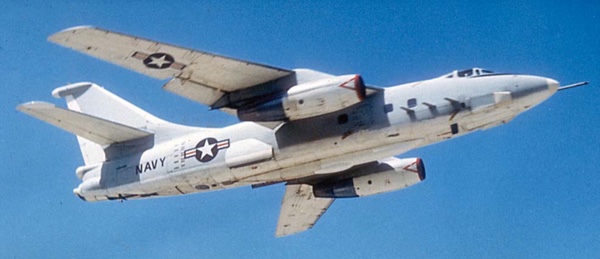 A Navy EA-3B aircraft used as part of Project SEABRINE. SEABRINE aircraft deployed from Alaska during the 1960s to intercept Soviet missile signals. (credit: NSA) |
Collecting signals in the air
In 1959, a U-2 flying along the Soviet-Iranian border collected telemetry from the first stage flight of a Soviet ICBM.[20] Aircraft had long been used to collect signals, particularly radar emissions, from the ground. They were soon put to use collecting signals from missiles. Some airborne platforms like the U-2 could operate at high altitude to essentially peer over the horizon at distant launch sites. Others could venture far from land to collect the signals closer to their source.
Bernard explains that often telemetry interceptions were tipped off by communications intelligence that provided indications of pending Soviet launches. This information led to the launch of special intercept craft such as modified Strategic Air Command EB-47E(TT) Stratojets operating under Project TELL TWO.[21] The EB-47s were limited and did not collect information on the first stages of launches from Baikonur. (Somewhat amusingly, the redacted history deletes “Tell Two” from the title of a 1990 magazine article written by Robert Hopkins III and in the public domain for three decades.) By 1965, a proposal to fly a re-engined RB-57F high-altitude aircraft that could gather the needed signals was rejected. But other RB-57F’s were flown by Pakistani pilots to conduct intercepts.[22]
One of the earliest efforts to intercept uplink data sent from the Earth’s surface to missiles in flight was conducted using a modified C-130 aircraft with a radar converted to work as a receiver. It was deployed to the Pacific Ocean where the NSA suspected Soviet ships were equipped to provide uplink data to missile launches.[23] Later on, US Navy A-3D aircraft were flown in the Pacific searching for uplinks under Project BUSY SIGNAL.[24]
US Navy EA-3B SEABRINE/FARMTEAM aircraft were also flown to conduct telemetry interceptions in the early 1960s and again in the late 1960s. The aircraft were based in Shemya and flew to Kamchatka to monitor missile reentries. However, some other missions flown out of Pakistan stopped in 1965 after war broke out between Pakistan and India, and the history implies that this may have led to restarting the SEABRINE flights from Alaska. This was one of the first times that local political unrest and disagreements affected US intelligence collection operations, but it certainly was not the last.[25]
| When Yuri Gagarin was launched into orbit in April 1961, the US intelligence community was waiting. |
By 1968, the Air Force had modified three EC-135 aircraft to collect communications, telemetry, electronic intelligence, and optical information. These COBRA BALL aircraft monitored Soviet reentry vehicles fired into the Kamchatka Peninsula or the Pacific Ocean, also operating under the name BURNING STAR, an obvious reference to a descending reentry vehicle.[26]
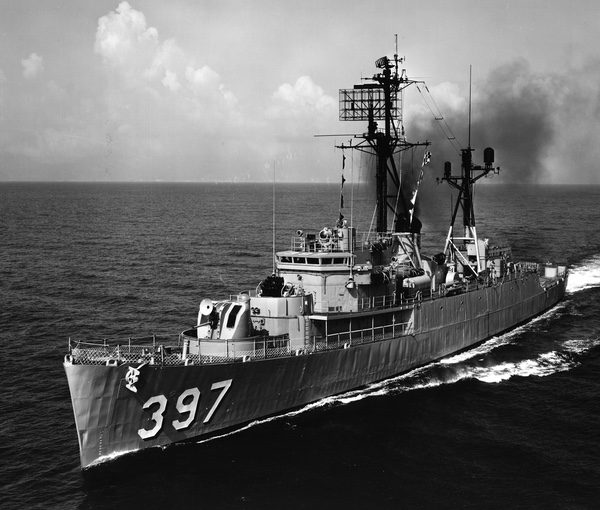 The USS Wilhoite was a radar picket destroyer pressed into service monitoring Soviet missile tests. (credit: US Navy) |
All the ships at sea
In addition to ground sites and aircraft, the US intelligence community operated ships to conduct intelligence collection. The use of some of these vessels in an intelligence-gathering role has rarely, if ever, been acknowledged. Early on, Military Sea Transport Ships USNS Valdez and USNS Robinson were converted to intercept signals, and along with the USS Liberty, they collected telemetry from Soviet satellites. One of them intercepted telemetry from the re-entry phase of Cosmonaut Titov in 1961.[27]
US Navy destroyer escort radar ships were also used for intelligence purposes. These were the USS Newell, USS Wilhoite, USS Lansing, USS Savage, and USS Vance.
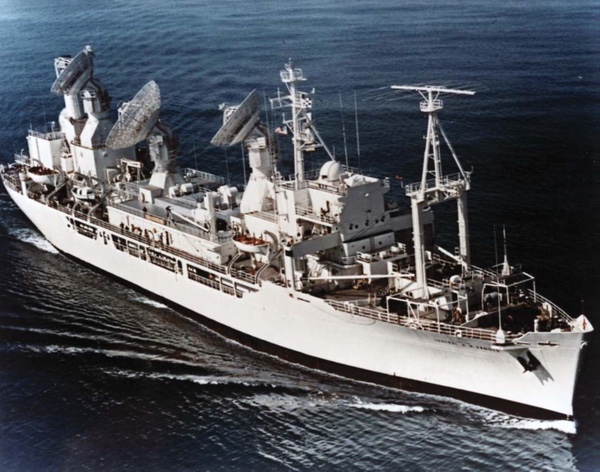 The USNS General H.H. Arnold, one of two ships developed to track American missile tests. The Arnold and sister ship General Hoyt S. Vandenberg were also used to track Soviet missiles and intercept their signals. (credit: NSA) |
In 1963, the Advanced Missile Range Information Ship USNS Timber Hitch was temporarily equipped with equipment shelters and personnel to intercept telemetry and other missile information. This began the ELEVENTH FATHOM program to employ missile range ships that collected data on American missile tests to also collect intelligence information on Soviet space and missile tests. Soon the USNS General H.H. Arnold and USNS General Hoyt S. Vandenberg, large missile range ships operating for the US Air Force also began serving in this role.[29] (See “V is for Virus, Volkov, and Vandenberg,” The Space Review, March 19, 2007.)
The number of ships being used to collect intelligence on Soviet missile and space operations soon expanded with the addition of four destroyer escorts: USS John B. Perry, USS Charles Berry, USS McMorris, and USS Claude Jones. The ships were outfitted with special interception equipment as part of BRIGHT CRESCENT, and usually operated in the western Pacific.[30] The small ships proved reliable when operating far from shore and often shadowed Soviet space tracking vessels. The McMorris was involved in an event when a Soviet lunar spacecraft splashed down in the ocean nearby. (See “Chasing the Zond,” The Space Review, February 9, 2009.)
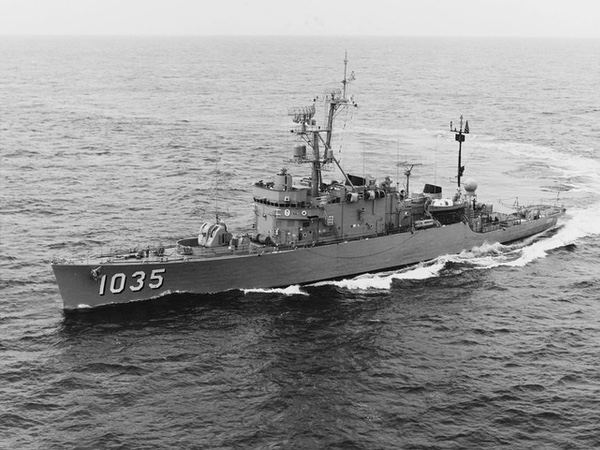 The USS Claude Jones was one of four small Navy ships used to monitor Soviet space and missile events. A sister ship, the USS McMorris, was involved in tracking one of the Zond lunar missions. (credit: US Navy) |
Aiming higher-intelligence collection on satellites and deep space missions
When Yuri Gagarin was launched into orbit in April 1961, the US intelligence community was waiting. They had previously collected and analyzed TV signals from an earlier canine flight at sites in Turkey and Iran, which led the intelligence community to prepare to collect future TV signals. When Gagarin’s spacecraft went into orbit, American facilities at Shemya, Alaska, and Helemano, Oahu, Hawaii, were equipped with special equipment and intercepted TV signals indicating there was a man inside the Vostok.[31]
By 1962, a couple of Soviet recoverable satellites launched from Baikonur alarmed the CIA for some reason that remains classified in the history, which noted “this added urgency to collecting signals from Soviet satellites.”[32]
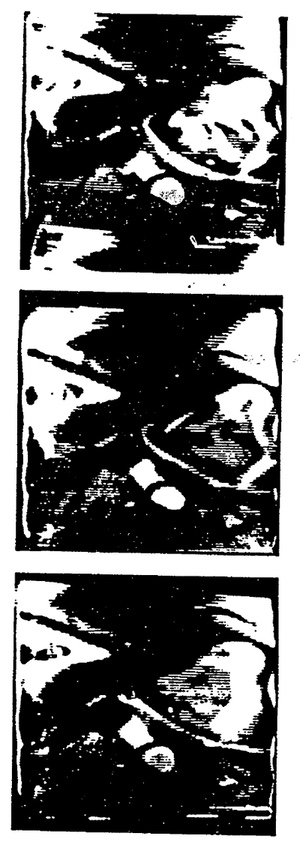 Intercepted television images from Yuri Gagarin's flight. The NSA had intercepted signals from an earlier canine flight and developed and deployed specialized equipment before Gagarin's mission. (credit: NSA) |
By the mid-1960s, the US intelligence community had established its priority list for collecting signals about Soviet satellites. The first priority was Soviet activities that reflected military activities, including space vehicles with weapons delivery capability; reconnaissance, weather, communication, electronic countermeasures, electronic intelligence, geodesy, and navigation satellites; maneuverable vehicles, manned or unmanned; space platforms; and the overall inventory of how Soviet spacecraft would be used in wartime. Secondary priority included biological probes and satellites, manned space vehicles, and lunar and planetary probes (both manned and unmanned.)[33]
American collection efforts continually improved and became more sophisticated throughout the 1960s. One source of data provided information making it possible to predict Soviet day-to-day planning for their reconnaissance satellites.[34] Although not mentioned in the history, an example was a collection effort focused on Soviet reconnaissance satellites in 1964–1965. A declassified report indicates that the United States was able to gather considerable amounts of information on these Soviet Cosmos satellites, including when and where they turned their cameras on and what kinds of systems they had aboard. According to a survey of nine Cosmos satellites, on average they expended about a quarter of their film photographing the United States, with the rest spread across many other targets such as China, South Vietnam, Turkey, Japan, and other American allies.
In 1965, the Soviet Union launched 26 ICBMs and 23 satellites, including the first Molniya communications satellite, and six deep space missions. The NSA was now receiving Soviet missile and satellite tracking data in near-real time, important for bringing other sensors to bear on the targets.[35]
| Bernard indicates that the collection of Soviet space vehicle telemetry was also directly helpful to the US space program, although the details of how this occurred remain classified. |
In the 1960s the NSA established a major ground station in Ethiopia and known as STONEHOUSE. STONEHOUSE was a “deep space” telemetry intercept site and played a key role in collecting signals from Soviet spacecraft, including their lunar and Venus missions. The National Security Agency has declassified information on STONEHOUSE in several other documents, and some information on what was collected there has been released over the decades. HIPPODROME in Turkey was used to obtain uplinks from Soviet ground stations in the Crimea to their spacecraft, while STONEHOUSE in Ethiopia could collect the faint signals coming back from the spacecraft.[36]
STONEHOUSE collected information from the Soviet Luna 9 mission in 1966. Another site collected important information from the Soviet Union’s prototype navigation satellite Cosmos 192, launched in 1967.[37]
The 1974 Ethiopian civil war prompted a hasty closure of the STONEHOUSE facility. A few years later, the Iranian revolution forced the CIA to leave its TACKSMAN sites there. These losses, combined with the closure of the Pakistan site in 1970, along with an interruption in operations in Turkey in the mid-1970s, presented major setbacks for American telemetry interception efforts. STONEHOUSE was the only NSA-operated facility in the proper location to receive the data from Soviet deep space vehicles. Its loss prompted a search for an alternative source, ultimately resulting in the NSA turning to their British counterpart, GCHQ, to provide the intelligence, although details remain classified.[38]
Bernard indicates that the collection of Soviet space vehicle telemetry was also directly helpful to the US space program, although the details of how this occurred remain classified. He cited JPL director William Pickering who reportedly said that the data “saved several hundred million dollars in the cost of the U.S. space program,” adding: “It is one of the few really tangible bits of evidence where you can claim that this particular bit of intelligence saved that particular amount of money. Unfortunately, we never got it in writing, nor did the SIGINT program receive a check for it, but it is a useful item to keep in mind.”[39]
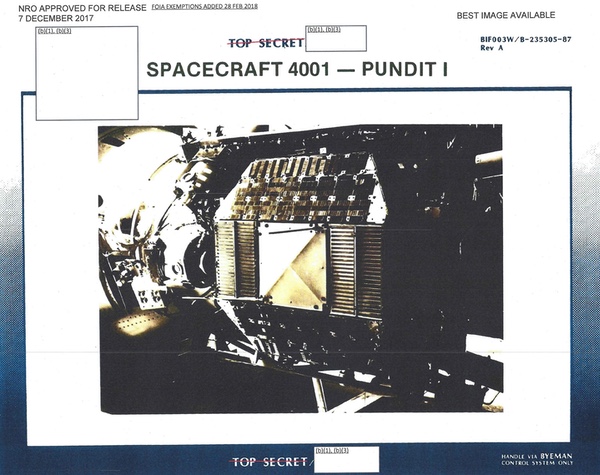 The PUNDIT I spacecraft, launched in late 1963, was designed to intercept telemetry from Soviet missile and rocket launches. Its name was a winking honor to government official Charles C. Tevis, who advocated the use of satellites for this mission. The PUNDIT satellites operated in low Earth orbit, which limited their time over the target. The early satellites encountered a dense signal environment that made telemetry interception difficult. Later satellites were equipped with filters to separate out the important signals. (credit: NRO) |
TELINT goes to space
Occasionally the US intelligence community considered novel collection techniques. Project BROADBENT was a study of the use of missiles and gun-launched projectiles to create cesium clouds in the upper atmosphere that could reflect signals from Soviet rockets fired at Kapustin Yar. But the idea was never implemented because of the provocation of launching rockets close to the Soviet border.[40]
Satellites proved to be somewhat less exotic than cesium clouds. Charles C. Tevis had pushed for telemetry interception satellites in low-Earth orbit starting in the early 1960s, and the first one was to be named SIVET—Tevis spelled backwards. But the name was changed, probably for security reasons, to PUNDIT, a comment on Tevis’ widely-respected intellect. The first PUNDIT satellite was launched in October 1963, followed by three more—one of them failing to orbit—with the last one in April 1965. The follow-on satellites, launched in 1967 and 1969, were named SAVANT, also a nod to Tevis’ intelligence. The early PUNDIT satellites did not collect much telemetry but indicated that the signal environment was very dense and required careful sifting. William Perry’s company, Electronic Systems Laboratory, conducted an analysis of the signals environment and built the payload for the last satellites. The analysis led to improved collection systems that could filter out the extraneous signals, and SAVANT was reportedly more successful than its predecessors in gathering Soviet missile and rocket signals.[41] (See “Wizards redux – revisiting the P-11 signals intelligence satellites,” The Space Review, September 7, 2021.)
According to Bernard, “satellite-collected telemetry together with overhead photography” was used to assess the Soviet N1 lunar rocket.[42] (See “A taste of Armageddon,” The Space Review, January 3, 2017, and part 2, January 9, 2017.)
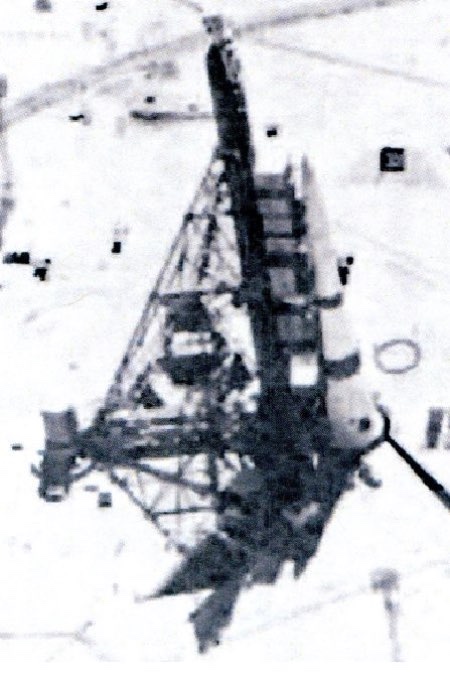 Soviet N1 rocket on the launch pad. The interception of signals by an American satellite tipped off the NSA about impending launches of the Soviet Union's massive Moon rocket. (credit: CIA) |
| Analysis of Soviet missile telemetry indicated that rather than a “crash” development program, the Soviets were moving at a more measured pace. The type of data also did not indicate an ICBM program that was being deployed, but one that was still in the research and development phase. |
Much of the section on telemetry collection from space is deleted in the history, although it has long been known that the CIA developed a satellite initially named RHYOLITE and later renamed AQUACADE and primarily designed for telemetry interception. Unlike PUNDIT and SAVANT, which did not spend much time over their targets, the CIA satellites operated in very high orbits, giving them the ability to gather missile test signals nearly all the time, including while the missiles and rockets were still on their launch pads. These new satellites required an overseas ground station, but it was established in Australia, a more stable country than Turkey, Pakistan, Ethiopia, or Iran. A portion of the history that has been deleted hints that another satellite system, most likely the CANYON communications intelligence satellites, provided information on impending Soviet space events, enabling ground controllers to prepare RHYOLITE to collect the telemetry when they did occur, similar to the way communications intelligence informed aircraft collection.
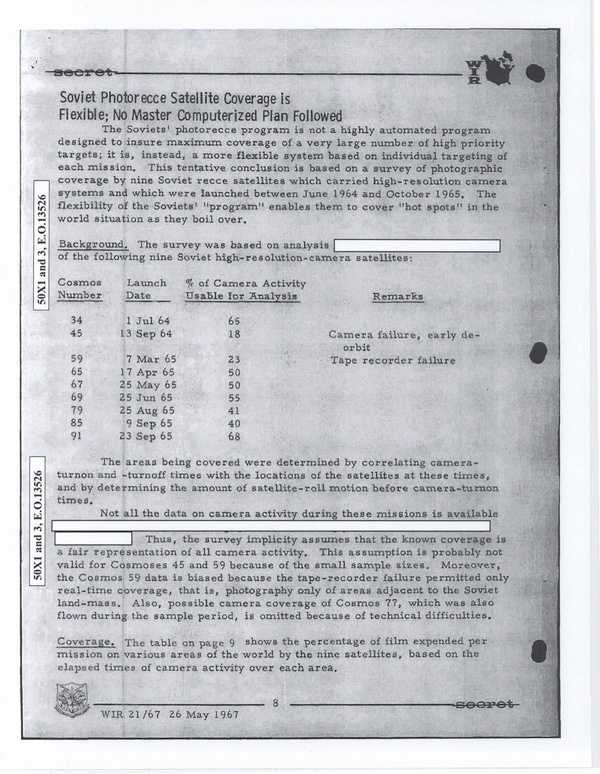 A declassified page from a report on Soviet space activities indicating just how much information was being collected from Soviet reconnaissance satellites in orbit. (credit: NSA) |
The importance of TELINT, and FISINT
In the mid and late 1960s, the DIA sponsored detailed studies of Soviet and Chinese weapon test ranges. These studies used intelligence gathered from communications and signals intelligence satellites as well as overhead imagery. The studies aided in gaining insights into how these countries developed weapons and what future weapons they might be testing.[43]
Bernard noted that telemetry interception data had major influences on geopolitics. For instance, the late 1950s “Missile Gap” controversy involved disputes within the US intelligence community and government over how many ICBMs the Soviet Union possessed. Although this dispute was eventually settled by photo-reconnaissance satellites that counted the number of Soviet launch sites and determined that instead than hundreds of ICBMs, the Soviet Union had only four, telemetry interceptions played a major role as well. Analysis of Soviet missile telemetry indicated that rather than a “crash” development program, the Soviets were moving at a more measured pace. The type of data also did not indicate an ICBM program that was being deployed, but one that was still in the research and development phase. This information was corroborated by materials supplied by Soviet spy Oleg Penkovsky.[44]
Similarly, during the 1962 Cuban Missile Crisis, telemetry intelligence was combined with reconnaissance photography of Soviet missiles in Cuba to provide a better indication of the kind of threat they posed to the US mainland.[45]
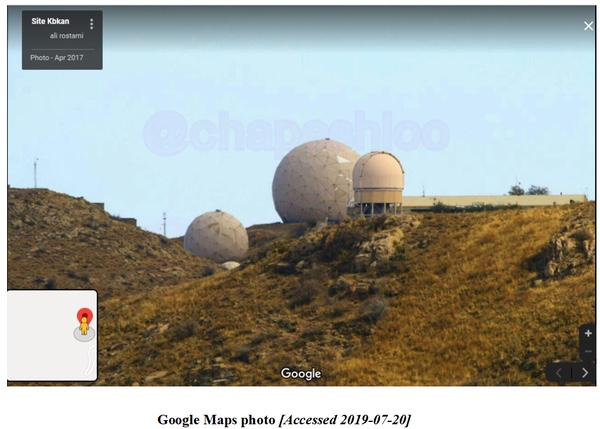 Google Maps image of one of the two TACKSMAN sites established by the CIA in Iran starting in the late 1950s. The dome on the right was for the LAZY CAT telescope system. (credit: Google Earth) |
Today, the US intelligence community does not use the terms telemetry or TELINT, instead using the term foreign instrumentation signature intelligence, or FISINT. FISINT encompasses much more than just signals from missiles and spacecraft.
The CIA set up two TACKSMAN sites that can be located with public software such as Google Earth: TACKSMAN I located at 36.6841 N, 53.5278 E, and TACKSMAN II, at 37.2963 N, 58.9131 E. In addition to the signals receivers, one of the sites included an advanced telescope known as LAZY CAT. Since the 1979 revolution, the Iranians have been using both locations. In commercially available satellite photos, the TACKSMAN I site looks like it has several large domes covering big dishes, and they have apparently been there for several decades. Recent imagery shows, on a site approximately 100 meters in the north-south direction by 50 meters east-west, five dish antennas of about 8 meters diameter. At least one and perhaps three of the dishes were installed post-2004. At least three have been moving around in azimuth since then, generally pointing southwest to southeast. At TACKSMAN II, site preparations began on a hill next to the main installation in 2019 but, perhaps due to the COVID-19 pandemic, no progress was made in 2020 and 2021.
The Iranians have not yet released a history of their activities on the Shah’s former hunting grounds.
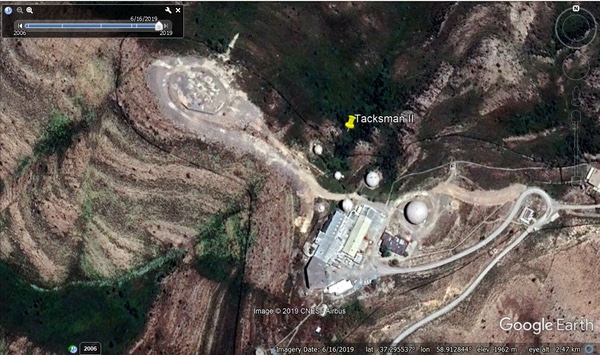 Google Earth image of the TACKSMAN II site in Iran. The CIA developed two sites in the mountains in northeastern Iran starting in the late 1950s. They were abandoned in 1979 after the Iranian revolution. Both sites have now been repurposed by the Iranian government, probably for intercepting signals from American and other satellites. (credit: Google Earth) |
The TELINT history can be downloaded from the National Archives website here, here, here, here, and here. Because of the somewhat confusing nature of the history’s organization, the specific chapter titles are used in my notes below.
Endnotes
- Richard L. Bernard, The Foreign Missile and Space TELEMETRY Collection Story – The First 50 Years Part 1, “Chapter 1, In the Beginning (1950s),” p. 21.
- Both Jeffrey Richelson and Des Ball wrote about some of these facilities. See for example https://nsarchive2.gwu.edu/NSAEBB/NSAEBB501/
- Part 1, “Introduction,” p. xiv.
- Part 1, “Chapter 2, The SPACOL Plan and DEFSMAC (Early 1960s),” p. 35.
- Part 1, “Chapter 1, In the Beginning (1950s),” p. 10.
- Part 1, “Chapter 2, The SPACOL Plan and DEFSMAC (Early 1960s),” p. 52.
- Part 1, “Chapter 1, In the Beginning (1950s),” p. 23.
- Part 2, “Chapter 2, Expansions to Meet Increasing Workload (1970s),” p. 5.
- Part 1, “Chapter 1, In the Beginning (1950s),” p. 8.
- Part 1, “Chapter 1, In the Beginning (1950s),” p. 21.
- Part 1, “Chapter 2, The SPACOL Plan and DEFSMAC (Early 1960s),” p. 47.
- Part 1, “Chapter 2, The SPACOL Plan and DEFSMAC (Early 1960s),” p. 32.
- Part 1, “Chapter 2, The SPACOL Plan and DEFSMAC (Early 1960s),” p. 54.
- Part 1, “Chapter 3, The Major Systems and Early Results (Late 1960s),” p. 55.
- Part 1, “Chapter 3, The Major Systems and Early Results (Late 1960s),” p. 60.
- Part 1, “Chapter 3, The Major Systems and Early Results (Late 1960s),” p. 55.
- Part 2, “Chapter 2, Expansions to Meet Increasing Workload (1970s),” p. 22.
- Part 2, “Chapter 2, Expansions to Meet Increasing Workload (1970s),” p. 27.
- Part 2, “Chapter 2, Expansions to Meet Increasing Workload (1970s),” p. 28.
- Part 1, “Chapter 2, The SPACOL Plan and DEFSMAC (Early 1960s),” p. 30.
- Part 1, “Chapter 2, The SPACOL Plan and DEFSMAC (Early 1960s),” p. 37.
- Part 1, “Chapter 2, The SPACOL Plan and DEFSMAC (Early 1960s),” p. 38.
- Part 1, “Chapter 2, The SPACOL Plan and DEFSMAC (Early 1960s),” p. 50.
- Part 1, “Chapter 2, The SPACOL Plan and DEFSMAC (Early 1960s),” p. 51.
- Part 1, “Chapter 2, The SPACOL Plan and DEFSMAC (Early 1960s),” p. 39.
- Part 1, “Chapter 3, The Major Systems and Early Results (Late 1960s),” p. 63; “Appendix B, 1950s/1960s Selected TELINT Asset Descriptions,” p. 79.
- Part 1, “Chapter 2, The SPACOL Plan and DEFSMAC (Early 1960s),” pp. 35-36.
- Part 1, “Chapter 2, The SPACOL Plan and DEFSMAC (Early 1960s),” p. 30.
- Part 1, “Chapter 2, The SPACOL Plan and DEFSMAC (Early 1960s),” p. 36.
- Part 1, “Chapter 2, The SPACOL Plan and DEFSMAC (Early 1960s),” p. 36; 78.
- Part 1, “Chapter 2, The SPACOL Plan and DEFSMAC (Early 1960s),” p. 34.
- Part 1, “Chapter 2, The SPACOL Plan and DEFSMAC (Early 1960s),” p. 33.
- Part 1, “Chapter 2, The SPACOL Plan and DEFSMAC (Early 1960s),” p. 40.
- Part 2, “Chapter 2, Expansions to Meet Increasing Workload (1970s),” p. 11.
- Part 1, “Chapter 3, The Major Systems and Early Results (Late 1960s),” p. 59.
- Part 2, “Chapter 2, Expansions to Meet Increasing Workload (1970s),” p. 29.
- Part 1, “Chapter 3, The Major Systems and Early Results (Late 1960s),” p. 65.
- Part 2, “Chapter 2, Expansions to Meet Increasing Workload (1970s),” p. 30 ; Part 2, “Chapter 3, Improved Worldwide Performance (1980s),” p. 58.
- Part 2, “Chapter 2, Expansions to Meet Increasing Workload (1970s),” p. 39.
- Part 1, “Chapter 2, The SPACOL Plan and DEFSMAC (Early 1960s),” p. 39.
- Part 2, “Chapter 2, Expansions to Meet Increasing Workload (1970s),” p. 8.
- Part 2, “Chapter 2, Expansions to Meet Increasing Workload (1970s),” p. 38.
- Part 2, “Chapter 2, Expansions to Meet Increasing Workload (1970s),” p. 14.
- Part 1, “Chapter 2, The SPACOL Plan and DEFSMAC (Early 1960s),” p. 51.
- Part 1, “Chapter 2, The SPACOL Plan and DEFSMAC (Early 1960s),” p. 51.
Note: we are using a new commenting system, which may require you to create a new account.
